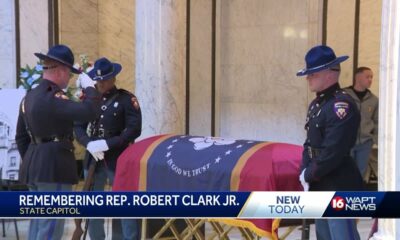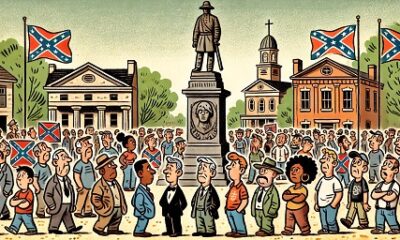Mississippi Today
On this day in 1865


Dec. 29, 1865

Months after the end of the Civil War, abolitionist leader William Lloyd Garrison produced the last issue of “The Liberator,” which he began publishing in 1831.
In the first issue, he wrote, “I will be as harsh as truth, and as uncompromising as justice. On this subject [of slavery], I do not wish to think, or speak, or write, with moderation. No! No! Tell a man whose house is on fire to give a moderate alarm; tell him to moderately rescue his wife from the hands of the ravisher; tell the mother to gradually extricate her babe from the fire into which it has fallen; —but urge me not to use moderation in a cause like the present. I am in earnest – I will not equivocate – I will not excuse – I will not retreat a single inch – and I will be heard.”
His fight to end slavery emanated from his deep faith, and he envisioned a world beyond bondage: “My Bible assures me that the day is coming when even the ‘wolf shall dwell with the lamb, and the leopard shall lie down with the kid, and the wolf and the young lion and the fatling together’; if this be possible, I see no cause why those of the same species—God’s rational creatures—fellow countrymen, in truth, cannot dwell in harmony together.”
Garrison worked, too, with the Underground Railroad and Harriet Tubman, whom he nicknamed “Moses.”
When the day came to celebrate the nation’s independence in 1854, Garrison and other members of the Massachusetts Anti-Slavery Society gathered for a picnic. He stood before them and chastised the U.S. Constitution, which regarded those enslaved as property, rather than people. He set a copy on fire and called it “a covenant with death and an agreement with hell.” He called for “amens” from the crowd, which exploded, “Amen!”
A pro-slavery mob tried to lynch him and would have succeeded if some sympathizers hadn’t turned him over instead to authorities. A gallows was even erected outside his office, and he was burned in effigy.
In addition to his work to end slavery, he became a leading advocate for women’s rights. With the last issue published, Garrison declared that his “vocation as an Abolitionist, thank God, has ended.” He continued to fight for the rights of African Americans and women. His works influenced Russian author Leo Tolstoy, Mahatma Gandhi and Martin Luther King Jr. A memorial in Boston now honors Garrison.
This article first appeared on Mississippi Today and is republished here under a Creative Commons license.![]()
Mississippi Today
Mississippians honor first Black lawmaker since Reconstruction
Mississippians honor first Black lawmaker since Reconstruction

Former Mississippi Rep. Robert Clark Jr. lay in state Sunday in the Capitol Rotunda as family, friends, officials and fellow citizens paid respect to the first Black legislator in the state since Reconstruction.
Clark, a Holmes County native, was elected to the House in 1967 and served until his retirement in 2004. He was elected speaker pro tempore by the House membership in 1993 and held that second-highest House position until his retirement.
The Senate and House honored the 96-year-old veteran lamaker last week.

“Robert Clark … broke so many barriers in the state of Mississippi with class, resolve and intellect. So he is going to be sorely missed,” Lt. Gov. Delbert Hosemann said last week.
Hosemann was among those who came Sunday to honor Clark. So did House Speaker Jason White, who like Clark hails from Holmes County.

Clark was the only Black Mississippian serving in the Legislature from until 1976 and was ostracized when first elected, sitting at a desk by himself for years without the traditional deskmates. But he rose to become a respected leader.
An educator when elected to the House, Clark served 10 years as chair of the House Education Committee, including when the historic Education Reform Act of 1982 was passed.
Clark served as the only Black Mississippian serving in the Legislature from 1968 until 1976.
“He was a trailblazer and icon for sure,” White said last week.




This article first appeared on Mississippi Today and is republished here under a Creative Commons license.![]()
Mississippi Today
On this day in 1912

March 9, 1912

Charlotta Bass became one of the nation’s first Black female editor-owners. She renamed The California Owl newspaper The California Eagle, and turned it into a hard-hitting publication. She campaigned against the racist film “Birth of a Nation,” which depicted the Ku Klux Klan as heroes, and against the mistreatment of African Americans in World War I.
After the war ended, she fought racism and segregation in Los Angeles, getting companies to end discriminatory practices. She also denounced political brutality, running front-page stories that read, “Trigger-Happy Cop Freed After Slaying Youth.”
When she reported on a KKK plot against Black leaders, eight Klansmen showed up at her offices. She pulled a pistol out of her desk, and they beat a “hasty retreat,”
The New York Times reported. “Mrs. Bass,” her husband told her, “one of these days you are going to get me killed.” She replied, “Mr. Bass, it will be in a good cause.”
In the 1940s, she began her first foray into politics, running for the Los Angeles City Council. In 1951, she sold the Eagle and co-founded Sojourners for Truth and Justice, a Black women’s group. A year later, she became the first Black woman to run for vice president, running on the Progressive Party ticket. Her campaign slogan: “Win or Lose, We Win by Raising the Issues.”
When Kamala Harris became the first Black female vice presidential candidate for a major political party in 2020, Bass’ pioneering steps were recalled.
“Bass would not win,” The Times wrote. “But she would make history, and for a brief time her lifelong fight for equality would enter the national spotlight.”
This article first appeared on Mississippi Today and is republished here under a Creative Commons license.![]()
Mississippi Today
On this day in 1977
On this day in 1977
March 8, 1977

Henry L. Marsh III became the first Black mayor of the former capital of the Confederacy, Richmond, Virginia.
Growing up in Virginia, he attended a one-room school that had seven grades and one teacher. Afterward, he went to Richmond, where he became vice president of the senior class at Maggie L. Walker High School and president of the student NAACP branch.
When Virginia lawmakers debated whether to adopt “massive resistance,” he testified against that plan and later won a scholarship for Howard University School of Law. He decided to become a lawyer to “help make positive change happen.” After graduating, he helped win thousands of workers their class-actions cases and helped others succeed in fighting segregation cases.
“We were constantly fighting against race prejudice,” he recalled. “For instance, in the case of Franklin v. Giles County, a local official fired all of the black public school teachers. We sued and got the (that) decision overruled.”
In 1966, he was elected to the Richmond City Council and later became the city’s first Black mayor for five years. He inherited a landlocked city that had lost 40% of its retail revenues in three years, comparing it to “taking a wounded man, tying his hands behind his back, planting his feet in concrete and throwing him in the water and saying, ‘OK, let’s see you survive.’”
In the end, he led the city from “acute racial polarization towards a more civil society.” He served as president of the National Black Caucus of Elected Officials and as a member of the board of directors of the National League of Cities.
As an education supporter, he formed the Support Committee for Excellence in the Public Schools. He also hosts the city’s Annual Juneteenth Celebration. The courthouse where he practiced now bears his name and so does an elementary school.
Marsh also worked to bridge the city’s racial divide, creating what is now known as Venture Richmond. He was often quoted as saying, “It doesn’t impress me to say that something has never been done before, because everything that is done for the first time had never been done before.”
He died on Jan. 23, 2025, at the age of 91.
This article first appeared on Mississippi Today and is republished here under a Creative Commons license.![]()
-

 News from the South - Louisiana News Feed5 days ago
News from the South - Louisiana News Feed5 days agoRemarkable Woman 2024: What Dawn Bradley-Fletcher has been up to over the year
-

 News from the South - Oklahoma News Feed2 days ago
News from the South - Oklahoma News Feed2 days agoFeed the Children rolls out new program to help Oklahoma families
-

 News from the South - Oklahoma News Feed4 days ago
News from the South - Oklahoma News Feed4 days agoMarch 6,2025: Rain and snow on the way
-

 News from the South - Texas News Feed5 days ago
News from the South - Texas News Feed5 days agoTravis County DA failed to meet deadline to indict murder suspect | FOX 7 Austin
-

 News from the South - North Carolina News Feed7 days ago
News from the South - North Carolina News Feed7 days agoConfederate monument in Edenton will remain in place for now
-

 Mississippi Today6 days ago
Mississippi Today6 days agoKey lawmaker reverses course, passes bill to give poor women earlier prenatal care
-

 Mississippi Today3 days ago
Mississippi Today3 days agoJudge tosses evidence tampering against Tim Herrington
-

 News from the South - South Carolina News Feed7 days ago
News from the South - South Carolina News Feed7 days agoUkraine’s Zelenskyy says end of war with Russia is ‘very, very far away’













































